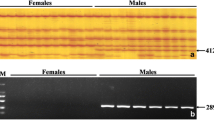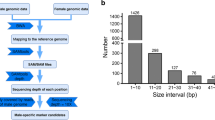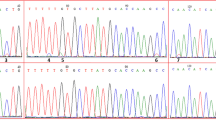Abstract
Sex-specific DNA markers applicable were very useful for elucidating the sex-determination mechanism and sex control in fishes. In the present study, amplified fragment-length polymorphism (AFLP) approach with 144 primer combinations was employed to identify sex-specific markers in the rock bream. Four male-specific AFLP fragments were identified which were designated as Opl286, Opl237, Opl422, and Opl228. Further sequence analysis of the sex markers’ genomic region revealed subtle differences between the males and females. We identified four male-specific single-nucleotide polymorphisms (SNPs) and a deletion of 8 bp in marker Opl286, six male-specific SNPs in marker Opl237, three male-specific SNPs in marker Opl422, and eight male-specific SNPs and 1 bp inversions in marker Opl228. Specific primers were designed based on the nucleotide variation in the sequences to develop a simple polymerase chain reaction method for identifying the genetic sex of rock bream. As a result, three out of the four male-specific markers were converted into SNP markers. The male-specific AFLP markers and AFLP-derived SNP markers were tested in 100 individuals collected from three locations around the coast of Zhoushan, yielding reproducible sex identification. These male-specific DNA markers are a useful tool for the identification of the sex-determining locus in rock bream and for guiding artificial breeding programs.





Similar content being viewed by others
References
Baroiller JF, D’Cotta H, Bezault E, Wessels S, Hoerstgen-Schwark G (2009) Tilapia sex determination: where temperature and genetics meet. Comp Biochem Phys A 153(1):30–38
Berset-Brandli L, Jaquiery J, Dubey S, Perrin N (2006) A sex-specific marker reveals male heterogamety in European tree frogs. Mol Biol Evol 23:1104–1106
Brugmans B, van der Hulst RG, Visser RG, Lindhout P, van Eck HJ (2003) A new and versatile method for the successful conversion of AFLP markers into simple single locus markers. Nucleic Acids Res 31:e55
Casas L, Sánchez L, Orbán L (2011) Sex-associated DNA markers from turbot. Mar Biol Res 7:378–387
Charlesworth D, Charlesworth B, Marais G (2005) Steps in the evolution of heteromorphic sex chromosomes. Heredity 95:118–128
Chen SL, Li J, Deng SP, Tian YS, Wang QY, Zhuang ZM, Sha ZX, Xu JY (2007) Isolation of female-specific AFLP markers and molecular identification of genetic sex in half-smooth tongue sole (Cynoglossus semilaevis). Mar Biotechnol 9:273–280
Chen SL, Ji XS, Shao CW, Li WL, Yang JF, Liang Z, Liao XL, Xu GB, Xu Y, Song WT (2012) Induction of mitogynogenetic diploids and identification of WW super-female using sex-specific SSR markers in half-smooth tongue sole (Cynoglossus semilaevis). Mar Biotechnol 14:120–128
Cioffi M, Bertollo L (2010) Initial steps in XY chromosome differentiation in Hoplias malabaricus and the origin of an X1X2Y sex chromosome system in this fish group. Heredity 105:554–561
Cioffi M, Martins C, Bertollo L (2009) Comparative chromosome mapping of repetitive sequences. Implications for genomic evolution in the fish, Hoplias malabaricus. BMC Genet 10:34
Devlin RH, Nagahama Y (2002) Sex determination and sex differentiation in fish: an overview of genetic, physiological, and environmental influences. Aquaculture 208:191–364
Ezaz MT, Harvey SC, Boonphakdee C, Teale AJ, McAndrew BJ, Penman DJ (2004) Isolation and physical mapping of sex-linked AFLP markers in Nile tilapia (Oreochromis niloticus L.). Mar Biotechnol 6:435–445
Felip A, Young WP, Wheeler PA, Thorgaard GH (2005) An AFLP-based approach for the identification of sex-linked markers in rainbow trout (Oncorhynchus mykiss). Aquaculture 247:35–43
Galindo HM, Loher T, Hauser L (2011) Genetic sex identification and the potential evolution of sex determination in Pacific halibut (Hippoglossus stenolepis). Mar Biotechnol 13:1027–1037
Griffiths R, Orr K (1999) The use of amplified fragment length polymorphism (AFLP) in the isolation of sex-specific markers. Mol Ecol 8:671–674
Griffiths R, Orr KL, Adam A, Barber I (2000) DNA sex identification in the three-spined stickleback. J Fish Biol 57:1331–1334
Gui JF (2007) Genetic basis and artificial control of sexuality and reproduction in fish. Science Press, Beijing, pp 35–62
Khamnamtong B, Thumrungtanakit S, Klinbunga S, Aoki T, Hirono I, Menasveta P (2006) Identification of sex-specific expression markers in the giant tiger shrimp (Penaeus monodon). J Biochem Mol Biol 39:37–45
Koshimizu E, Strussmann CA, Okamoto N, Fukuda H, Sakamoto T (2010) Construction of a genetic map and development of DNA markers linked to the sex-determining locus in the Patagonian pejerrey (Odontesthes hatcheri). Mar Biotechnol 12:8–13
Kovacs B, Egedi S, Bartfai R, Orban L (2001) Male-specific DNA markers from African catfish (Clarias gariepinus). Genetica 110:267–276
Lee BY, Hulata G, Kocher TD (2004) Two unlinked loci controlling the sex of blue tilapia (Oreochromis aureus). Heredity 92:543–549
Lee BY, Coutanceau JP, Ozouf-Costaz C, Cotta HD, Baroiller JF, Kocher TD (2011) Genetic and physical mapping of sex-linked AFLP markers in Nile tilapia (Oreochromis niloticus). Mar Biotechnol 13:557–562
Liao X, Ma HY, Xu GB, Shao CW, Tian YS, Ji XS, Yang JF, Chen SL (2009) Construction of a genetic linkage map and mapping of a female-specific DNA marker in half-smooth tongue sole (Cynoglossus semilaevis). Mar Biotechnol 11:699–709
Liu ZJ, Cordes JF (2004) DNA marker technologies and their applications in aquaculture genetics. Aquaculture 238:1–37
Matsuda M, Nagahama Y, Shinomiya A, Sato T, Matsuda C, Kobayashi T, Morrey CE, Shibata N, Asakawa S, Shimizu N (2002) DMY is a Y-specific DM-domain gene required for male development in the medaka fish. Nature 417:559–563
Meng QW, Su JX, Miao XZ (1995) Fish taxonomy. China Agriculture Press, Beijing, pp 734–756
Nagler J, Bouma J, Thorgaard G, Dauble D (2001) High incidence of a male-specific genetic marker in phenotypic female chinook salmon from the Columbia River. Environ Health Persp 109:67–69
Nanda I, Kondo M, Hornung U, Asakawa S, Winkler C, Shimizu A, Shan Z, Haaf T, Shimizu N, Shima A (2002) A duplicated copy of DMRT1 in the sex-determining region of the Y chromosome of the medaka, Oryzias latipes. PNAS 99:11778–11783
Perry GML, Ferguson MM, Sakamoto T, Danzmann RG (2005) Sex-linked quantitative trait loci for thermotolerance and length in the rainbow trout. J Hered 96:97–107
Sandra GE, Norma MM (2010) Sexual determination and differentiation in teleost fish. Rev Fish Biol Fisher 20:101–121
Ueno K, Takai A (2008) Multiple sex chromosome system of X1X1X2 X2/X1 X2Y type in lutjanid fish, Lutjanus quinquelineatus (Perciformes). Genetica 132:35–41
Ventura T, Aflalo ED, Weil S, Kashkush K, Sagi A (2011) Isolation and characterization of a female-specific DNA marker in the giant freshwater prawn Macrobrachium rosenbergii. Heredity 107:456–461
Volff JN, Kondo M, Schartl M (2003) Medaka dmY/dmrt1Y is not the universal primary sex-determining gene in fish. Trends Genet 19:196–199
Vos P, Hogers R, Bleeker M, Reijans M, Lee T, Hornes M, Friters A, Pot J, Paleman J, Kuiper M (1995) AFLP: a new technique for DNA fingerprinting. Nucleic Acids Res 23:4407–4414
Wang D, Mao HL, Chen HX, Liu HQ, Gui JF (2009) Isolation of Y- and X-linked SCAR markers in yellow catfish and application in the production of all-male populations. Anim Genet 40:978–981
Xu D, You F, Lou B, Geng Z, Li J, Xiao ZZ (2012) Comparative analysis of karyotype and C-banding in male and female Oplegnathus fasciatus. Acta Hydrobiol Sinica 36:552–557 (In Chinese)
Acknowledgments
This work was financially supported by the National Natural Science Foundation of China (41106114), the National Science and Technology Pillar Program of China (2011BAD13B08), and the Project of Zhejiang Province of China (2010R50025; 2010F20006).
Author information
Authors and Affiliations
Corresponding authors
Rights and permissions
About this article
Cite this article
Xu, D., Lou, B., Xu, H. et al. Isolation and Characterization of Male-Specific DNA Markers in the Rock Bream Oplegnathus fasciatus . Mar Biotechnol 15, 221–229 (2013). https://doi.org/10.1007/s10126-012-9480-1
Received:
Accepted:
Published:
Issue Date:
DOI: https://doi.org/10.1007/s10126-012-9480-1




